Neolitsea dealbata
Neolitsea dealbata, also known as white bolly gum, hairy-leaved bolly gum, or simply bolly gum (amongst others)[lower-alpha 1], is a shrub or small tree in the laurel family Lauraceae which is native to New South Wales and Queensland in Australia.
| Bolly gum | |
|---|---|
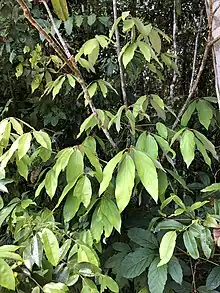 | |
| Scientific classification | |
| Kingdom: | Plantae |
| Clade: | Tracheophytes |
| Clade: | Angiosperms |
| Clade: | Magnoliids |
| Order: | Laurales |
| Family: | Lauraceae |
| Genus: | Neolitsea |
| Species: | N. dealbata |
| Binomial name | |
| Neolitsea dealbata | |
| Synonyms[4] | |
| |
Description
The bolly gum is an evergreen tree growing up to 15 m (49 ft) high, the trunk can reach 30 cm (12 in) diameter and may be buttressed.[5][6][7] The twigs are densely covered in fine brown hairs on the younger parts and are terete (circular in cross-section).[5][6][7] The leaves are generally elliptic but may be obovate or lanceolate, and new growth is also covered in brown hairs.[5][6][7] They measure between 7 and 22 cm (2.8 and 8.7 in) long by 3 and 8 cm (1.2 and 3.1 in) wide.[5][6][7] The upper surface is glossy green, the underside is whitish or glaucous.[5][6][7]
The inflorescence is an umbel produced in the leaf axils or directly from the twigs. There are up to five flowers per umbel, cream, yellow or pale brown in colour, and measuring from 2 to 8 cm (0.79 to 3.15 in) long. The female flowers are about half as long as male ones.[5] The globose (roughly spherical) fruit is a drupe up to 11 mm (0.43 in) in diameter, green when immature and dark red to black when ripe, and they contain a single seed.[5][6][7]
Taxonomy
This species has been given several names since it was first described in 1810 by the Scottish botanist Robert Brown, who originally called it Tetranthera dealbata.[3] Later, the genus Tetranthera was subsumed by Litsea Lam., and the German botanist Nees von Esenbeck published a new name for the species - Litsea dealbata - in 1836.[8][9] In 1838 Constantine Samuel Rafinesque, a French polymath, again revised T. dealbata in his book Sylva telluriana and gave it the new combination Bryantea dealbata.[10][11]
Rafinesque's work, despite being a validly published name, was largely ignored by his contemporaries and in 1948 the American botanist Elmer Drew Merrill published a new combination that is still accepted, i.e. Neolitsea dealbata.[9][12]
Etymology
The genus name Neolitsea is a combination of the Ancient Greek word néos (meaning "new") and the pre-existing genus name Litsea. The members of Neolitsea were mostly transferred from Litsea. The species epithet dealbata is Latin for "whitewashed", and refers to the white undersides of the leaves.[13]
Vernacular names
Many common names have been used for this plant, including those in the following list. Other variations exist which are minor differences between, for example, "bollygum" and "bolly gum", etc.[1][6][5]
- black ash
- bolly gum
- grey bollywood
- native mulberry
- pigeon-berry tree
- white bollywood
- white bollygum
- velvet-leaf bollywood
- hairy-leaved bollygum
Distribution and habitat
The bolly gum has a wide distribution on the coast and adjacent tablelands of eastern Australia, stretching from islands of the Torres Strait south to the Illawarra region south of Sydney.[14] It is an understory species found in rainforest and wet sclerophyll forest on a variety of soil types, and at altitudes from sea level to 1,150 m (3,770 ft).[5][7][6]
Ecology
This plant is a host species for larvea of the moths Acrocercops ordinatella and Gibbovalva quadrifasciata, as well as the blue triangle butterfly (Graphium sarpedon).[15] Cassowaries (Casuarius casuarius) and fruit doves (genus Ptilinopus) are known to eat the fruit of these trees, and its likely that many other frugivorous birds do so as well.[6] The fungus Phyllachora queenslandica is found on Neolitsea dealbata.[16]
Gallery
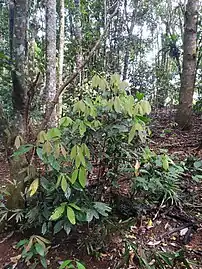 Young plant in rainforest near Malanda, Queensland
Young plant in rainforest near Malanda, Queensland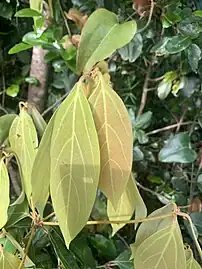 New growth
New growth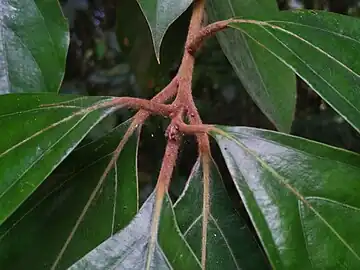 Dense brown hairs on twigs and petioles
Dense brown hairs on twigs and petioles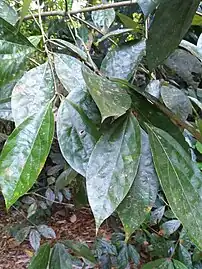 Foliage
Foliage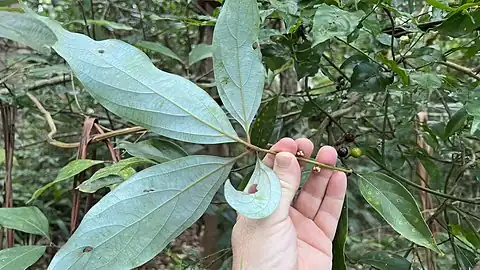 Underside of leaves
Underside of leaves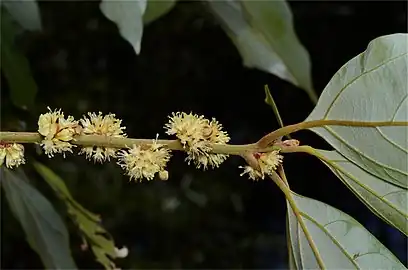 Inflorescences
Inflorescences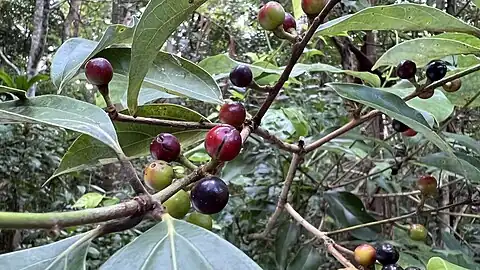 Fruit in various stages of development
Fruit in various stages of development
References
- "Species profile—Neolitsea dealbata". Queensland Department of Environment and Science. Queensland Government. 2022. Retrieved 13 May 2023.
- IUCN SSC Global Tree Specialist Group; Botanic Gardens Conservation International (BGCI). (2019). "Neolitsea dealbata". IUCN Red List of Threatened Species. 2019: e.T158692171A158692173. doi:10.2305/IUCN.UK.2019-3.RLTS.T158692171A158692173.en. Retrieved 13 May 2023.
- "Neolitsea dealbata". Australian Plant Name Index (APNI). Centre for Australian National Biodiversity Research, Australian Government. Retrieved 13 May 2023.
- "Neolitsea dealbata (R.Br.) Merr". Plants of the World Online. Royal Botanic Gardens, Kew. Retrieved 13 May 2023.
- Le Cussan, J.; Hyland, B.P.M. (2022). Busby, John R. (ed.). "Neolitsea dealbata". Flora of Australia. Australian Biological Resources Study, Department of Climate Change, the Environment and Water: Canberra. Retrieved 13 May 2023.
- F.A.Zich; B.P.M.Hyland; T.Whiffen; R.A.Kerrigan (2020). "Neolitsea dealbata". Australian Tropical Rainforest Plants Edition 8 (RFK8). Centre for Australian National Biodiversity Research (CANBR), Australian Government. Retrieved 13 May 2023.
- "PlantNET - FloraOnline". PlantNET (The NSW Plant Information Network System). Royal Botanic Gardens and Domain Trust, Sydney. Retrieved 13 May 2023.
- "Litsea dealbata". International Plant Names Index (IPNI). Royal Botanic Gardens, Kew. 2023. Retrieved 13 May 2023.
- Merrill, E.D. (1948). "Neolitsea (Bentham) Merrill. Nomen Conservandum Propositum". Journal of the Arnold Arboretum. 29 (2): 198–201. doi:10.5962/p.324623. S2CID 240322908. Retrieved 13 May 2023.
- "Bryantea dealbata". International Plant Names Index (IPNI). Royal Botanic Gardens, Kew. 2023. Retrieved 13 May 2023.
- Rafinesque, C.S. (1838). Sylva telluriana. Philadelphia. Retrieved 13 May 2023.
- "Neolitsea dealbata". International Plant Names Index (IPNI). Royal Botanic Gardens, Kew. 2023. Retrieved 13 May 2023.
- Cooper, Wendy; Cooper, William T. (June 2004). Fruits of the Australian Tropical Rainforest. Clifton Hill, Victoria, Australia: Nokomis Editions. p. 265. ISBN 9780958174213.
- "Search: species: Neolitsea dealbata | Occurrence records". Australasian Virtual Herbarium. Australian Government. Retrieved 13 May 2023.
- Robinson, Gaden S.; Ackery, Phillip R.; Kitching, Ian; Beccaloni, George W.; Hernández, Luis M. "HOSTS - a Database of the World's Lepidopteran Hostplants". Natural History Museum. Retrieved 13 May 2023.
- Pearce, Ceridwen A.; Hyde, Kevin D. (November 1993). "The genus Phyllachora from Australia: P. queenslandica and notes on P. apiculata from Neolitsea". Mycological Research. 97 (11): 1328–1332. doi:10.1016/S0953-7562(09)80165-2.
External links
 Data related to Neolitsea dealbata at Wikispecies
Data related to Neolitsea dealbata at Wikispecies Media related to Neolitsea dealbata at Wikimedia Commons
Media related to Neolitsea dealbata at Wikimedia Commons- View a map of historical sightings of this species at the Australasian Virtual Herbarium
- View observations of this species on iNaturalist
- View images of this species on Flickriver
Notes
- See Vernacular names section
